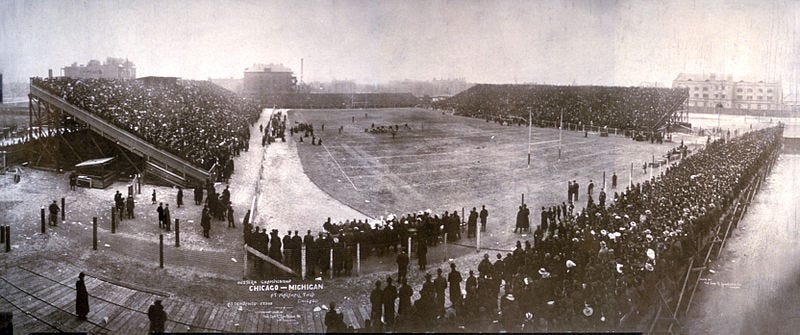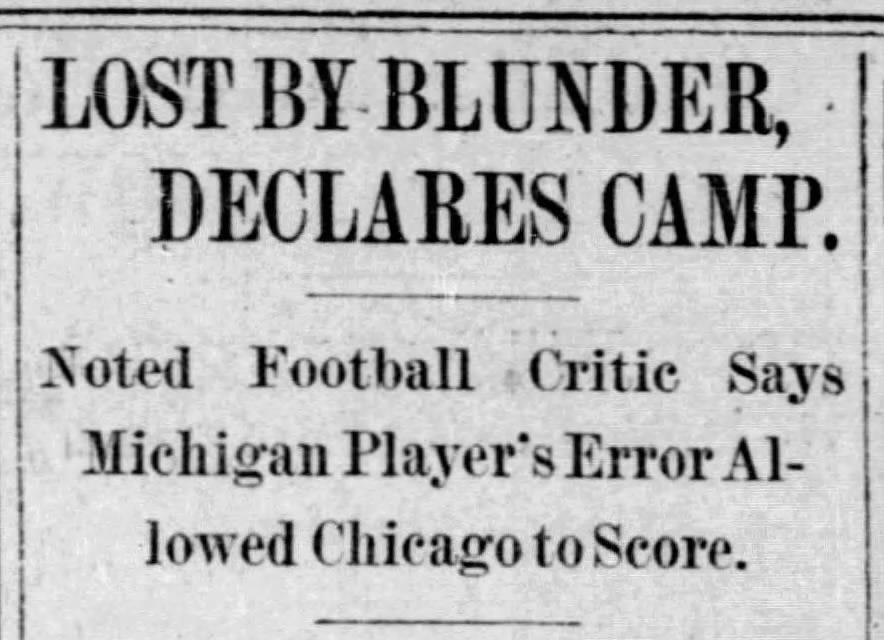Today's Tidbit... Michigan's Goal Line Punt Return of 1905
With just over 50 seconds left in the 2024 Rose Bowl, Alabama punted from its 42-yard line. The towering kick sailed to the 6-yard line, where Michigan's Jake Thaw muffed it before recovering the ball on the 1-yard line, where he was immediately tackled and thrown into the end zone. Under today's football rules, the sequence did not result in a safety; instead, Michigan received the ball at the 1-yard line. Things were not always so, and a similar event in the 1905 Chicago-Michigan game -played for the effective national championship- encouraged football to adopt the forward progress rule in 1906.
The Maroons and Wolverines were bitter rivals when they met in Chicago on Thanksgiving Day, 1905. Michigan entered the game riding a 56-game win streak, having outscored opponents 495-0 in the first twelve games of the season, while Chicago had outscored its opponents by a mere 269-5 in its nine games.
In a tough, back-and-forth battle for the Western Conference championship, the score was tied 0-0 with several minutes left in the fourth quarter. At that point, Chicago's quarterback, Walter Eckersall, punted from the middle of the field, sending the ball just across the goal line.
Under the rules at the time, any Chicago player behind the quarterback when he booted the ball could recover the punt, much like today's onside kickoff. Likewise, a Michigan player fielding the punt behind the goal line could touch it down for a touchback, in which case, Michigan would "kickout" to Chicago from the 25-yard line, much like safeties operate today.
As it happened, Michigan had two men back to return the punt. One of them, Denny Clark, fielded the ball behind the goal line, raced left, broke a tackle, and crossed the goal line to enter the field of play. Clark reached the 2-yard line before being hit by Chicago's Mark Caitlin. The hit lifted Clark into the air, sending the pair crashing to the ground behind the goal line. Since football did not yet have a forward progress rule, Clark's landing behind the goal line resulted in a safety, making the score 2-0. The 2-0 score held for the game’s last few minutes, so Chicago won the game, the Western Conference, and the national championship.
Denny Clark was distraught over his mistake, refusing to remove his uniform or attend the team dinner at the hotel that evening. He also vowed never to return to Ann Arbor and threatened suicide. Clark did return to Ann Arbor but soon transferred to MIT. A troubled man, he made good on the suicide threat in 1932.

With football facing many challenges due to the era’s dangerous play, the rule makers enacted a series of changes for the 1906 season. Among those was to expand the definition of the ball carrier being down. As before, the ball carrier was down when any part of his body touched the ground other than his hands or feet. In addition, the ball carrier was down when his forward progress stopped. The concept of forward progress has remained in place since 1906, which saved Michigan in the Rose Bowl the other night but did not do so back in 1905.
Football Archaeology is reader-supported. Click here to buy one of my books or otherwise support the site.




Reminds me of the safety in the Iowa upset of Ohio State in 1952. I'm not sure what the rules were in 1952, but it doesn't look like a safety to me now. Video appears at the 2 minute mark of The Evy Era at Iowa which is on Youtube.
I love the two day old Rose Bowl play sequence tie in to the game , again involving Michigan almost 120 years earlier! Fantastic history here!